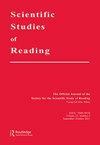What Underlies the Deficit in Rapid Automatized Naming (RAN) in Adults with Dyslexia? Evidence from Eye Movements
IF 2.4
2区 教育学
Q1 EDUCATION & EDUCATIONAL RESEARCH
引用次数: 8
Abstract
ABSTRACT This eye-tracking study explored how phonological encoding and speech production planning for successive words are coordinated in adult readers with dyslexia (N = 22) and control readers (N = 25) during rapid automatized naming (RAN). Using an object-RAN task, we orthogonally manipulated the word-form frequency and phonological neighborhood density of the object names and assessed the effects on speech and eye movements and their temporal coordination. In both groups, there was a significant interaction between word frequency and neighborhood density: shorter fixations for dense than for sparse neighborhoods were observed for low- but not for high-frequency words. This finding does not suggest a specific difficulty in lexical phonological access in dyslexia. However, in readers with dyslexia only, these lexical effects percolated to the late processing stages, indicated by longer offset eye-speech lags. We close by discussing potential reasons for this finding, including suboptimal specification of phonological representations and deficits in attention control or in multi-item coordination.阅读障碍成年人在快速自动命名(RAN)方面的缺陷是什么?眼动证据
摘要:这项眼动追踪研究探讨了在快速自动命名(RAN)过程中,阅读障碍成年读者(N=22)和对照读者(N=25)如何协调连续单词的语音编码和语音生成计划。使用对象RAN任务,我们对对象名称的词形频率和语音邻域密度进行了正交处理,并评估了对语音和眼动及其时间协调的影响。在这两组中,单词频率和邻域密度之间存在显著的相互作用:对于低频率单词,密集邻域的固定时间比稀疏邻域的短,但对于高频单词则没有。这一发现并没有表明阅读障碍患者在词汇语音访问方面存在特定的困难。然而,在仅患有阅读障碍的读者中,这些词汇效应渗透到了后期处理阶段,表现为较长的抵消性眼动滞后。最后,我们讨论了这一发现的潜在原因,包括语音表征的次优规范以及注意力控制或多项目协调的缺陷。
本文章由计算机程序翻译,如有差异,请以英文原文为准。
求助全文
约1分钟内获得全文
求助全文
来源期刊

Scientific Studies of Reading
Multiple-
CiteScore
7.20
自引率
2.70%
发文量
26
期刊介绍:
This journal publishes original empirical investigations dealing with all aspects of reading and its related areas, and, occasionally, scholarly reviews of the literature, papers focused on theory development, and discussions of social policy issues. Papers range from very basic studies to those whose main thrust is toward educational practice. The journal also includes work on "all aspects of reading and its related areas," a phrase that is sufficiently general to encompass issues related to word recognition, comprehension, writing, intervention, and assessment involving very young children and/or adults.
 求助内容:
求助内容: 应助结果提醒方式:
应助结果提醒方式:


